BIMSTEC Restructuring of South/East Asia or Defunct of SAARC


Kathmandu valley is renovated vigorously for 4th BIMSTEC summit that is to be held from 30 to 31 August. The intensified road cleaning and hurried road construction indicates something miracle is about to happen in the city. Nepal Government is eager to welcome this opportunity to cash it in its favor for its overall development as a host nation, though the main focus of the summit will be to increase connectivity among the BIMSTEC nations including transmission lines, airways, climate change, and road connectivity. Poverty alleviation might also get the top priority in the summit as well.
This sub-regional grouping mainly priories in the well being of South Asia and South East Asian countries along the coast of Bay of Bangal. It aims to serve as a bridge among the member nations Bhutan, Bangaladesh, Nepal, India, Myanmar, Srilanka, and Thailand. Restructuring and redefining the regional cooperation and fraternity is praiseworthy but forgetting the role of long established SAARC may hinder the calculated progress of the member nations. Neglecting the presence of Pakistan in the name of terrorism does not help in ascertain the peace and prosperity in the region. The abrupt rise of BIMSTEC has created suspense and skepticism. Whether is it initiated to counter and defunct the SAARC and pushing Pakistan to a lonely solitary space? The critics are susceptible, if Thailand and Srilanka, which are at the longest distance from the Bay of Bangal can be the member states for BIMSTEC why not Pakistan?
The question is yet to be answered and there may be many hidden political and non political reasons behind it. What is believed in the intellectual arena is that India is promoting this BIMSTEC to undermine the SAARC and isolate Pakistan as well. The intellectuals opine that India is staging a brilliant geo-political gambling using Nepalese territory to divert China’s Road and Belt Initiative that may have lasting impact against India’s hegemony towards its territorial small nations.
It would only be the ethnocentric view to look at Pakistan with the same old version of definition even after the rise of new reformative political scenario and liberal leader, the former cricketer and present Prime Minister of Pakistan, Imran Khan. His initial strategy has given enough signs that he is desperate to find out a strategic solution for the regional peace and territorial harmony.
The aim to make Nepal a vibrant economic zone as stated by P.M KP Sharma Oli is impossible without maintaining balanced relations between these two Asian power houses. Since what matters for them is their interest not on what Nepali are interested in. For instance, both of the nations signed on a document without consulting Nepal to start a trading through the border region of Lipulake, that lies in the tri-junction of India, China, and Nepal.
Oli is in full swing that he has the capacity to back up both of the giants for economic transformation of the nation. Managing the dispute is the gigantic task but with the willful intention, K.P Sharma Oli has the opportunity to settle down the clash of South Asian nations, especially Pakistsan and India, since Nepal is the chair of both SAARC and BIMSTEC. Cashing this occasion to rise from national leader to South East Asian leader is exigent yet Oli has the potentiality to prove as a worthy leader. What he needs is to elevate himself from petty domestic exigency being the bridge among the nations. Defunctness of SAARC can again be alive and Nepali are keen to see this happen in the prime time of Oli.
The cleverness of Nepal lies in milking the most out of this relation without being the escape-goat of either of the nations. Nepal needs to move strategically since both of the nations may try to impose their vested interests and our leaders should think not to make this nation a buffer zone for their playfulness. Our mastery lies in tackling the cunning game with mindfulness.
The author has completed his M.Phil Degree in International Relations

 Bhoj Kumar Dhamala
Bhoj Kumar Dhamala




Feedback